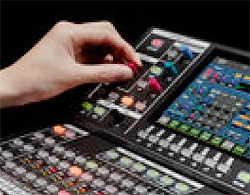
Mix Buses
Managing inputs is one thing; but how many ways can you combine them? That’s the real measure of a console. And this is where they start to diverge a little bit.
The M-200i goes a “big console” route with 8 mix buses and 4 matrix mixes. That’s a total of 12, which is not really the big leagues, but the matrix is nice. Each matrix can take input from any input channel or aux mix, so they can be used like auxes if you want. Of course you have the 2 channel main bus, and 8 DCAs (which aren’t really mixes but are darn handy). All of the mix buses has EQ and dynamics available.
The X32 sees those 12 mix buses and raises it 4. In addition to LCR (3 main) outputs, it also has 16 mix buses (which can act like auxes or groups) plus another 6 matrix mixes.
Like the M-200i, the mix buses have EQ and dynamics, however, the X32 boasts a 6 band PEQ, instead of the 4-band of the M200i. You also get 8 DCAs.
The StudioLive 24.4.2 offers 10 aux buses and 4 subgroups. In this way, it is much more like an analog console. You get graphic EQs on the auxes, but it doesn’t appear to have dynamics.
Built-In Effects
One of the big benefits of digital is the ability to do away with racks and racks of outboard gear that’s necessary with analog mixers. Each of these desks have a set of built-in effects, not to mention compression, gating and EQ on every channel.
Now, we’re not going to talk about the quality of the effects here; this is a feature comparison only. Generally speaking, the quality of the effects in smaller boards is not as good as it is in larger ones. It’s just a question of a price point, really. You can’t expect to get the super-high quality sound of a $1,500 effects unit in a console that costs $3,000, give or take. Still, each console gives you some built-in options.
The M-200i has 4 effects “racks” and a somewhat limited selection of built in effects. I’m not sure what the final spec is yet, but when I tried to load more than 1 stereo reverb, I got a dialog telling me that only 1 stereo reverb can run at a time. That leaves the other racks open for, well, not much other than simple delays and not so useful effects like flangers, phasers and choruses. I’d much prefer more reverbs.
You can also use the 4 effects racks as 31-band EQs (in addition to the 4 dedicated 31-bands). This is where limited DSP starts to come into play; you can only do so much with the DSP in a $3,500 console. It’s a bit of a limitation, but keep in mind the overall price point of this mixer; it’s amazing it does what it does.
The X32 really beefs up on the effects rack with 8 true-stereo processors (or 16 mono). However, it can run just 4 stereo reverbs at once. Reverb really burns up the DSP, so you can see everyone has to be careful what they allow. You can, however, run 4 reverbs with 8 GEQs at once. So that’s nice. Behringer also lets you download effects from their website.
The StudioLive 24.4.2 includes 2 FX engines with 50 preset effects to choose from. Each effect has a variety of parameters that can be edited, saved and recalled. You also get four dual-channel 31-band EQs that can be put on any of the outputs; subgroups, auxes and mains.
PreSonus also recently introduced Smaart acoustic measurement software built into the console to help you set those EQs up properly. One thing I like about the StudioLive is that you don’t have to burn an aux to use the FX. Each FX engine has it’s own “aux.” So that’s nice.
We’re getting through it all, but there is one key component (and probably another minor one) left; iPad control. Each of these consoles can be controlled via iPad, but the way they go about it is quite different. Next time, we’ll look to see how each implements remote mixing.
Mike Sessler is the Technical Director at Coast Hills Community Church in Aliso Viejo, CA. He has been involved in live production for over 20 years and is the author of the blog Church Tech Arts. He also hosts a weekly podcast called Church Tech Weekly on the TechArtsNetwork.
